Ford Ranger review: love pick-ups or loathe them, this is simply the best
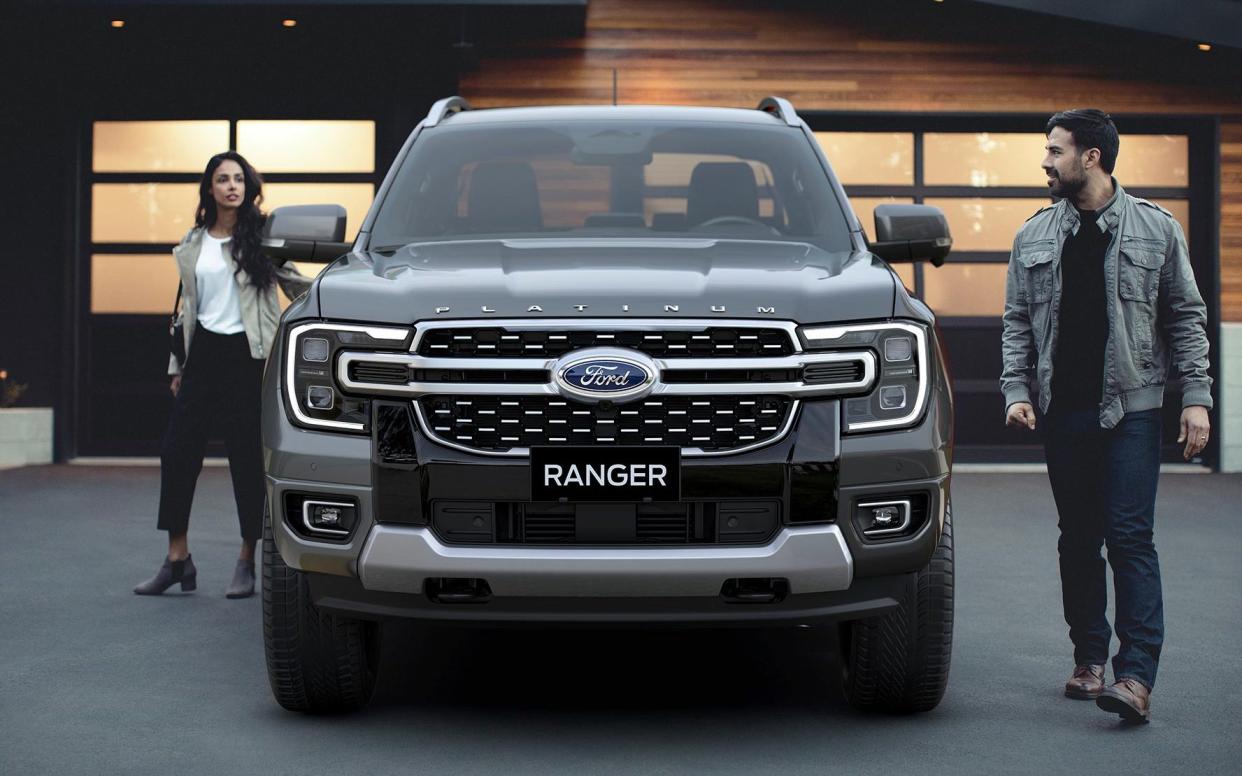
Remember Ford’s Granada Scorpio executive saloon? Believe it or not, you’re looking at its spiritual successor. Because while the Ranger Platinum might not be the priciest or most prestigious vehicle in the Ford range, the tax advantages inherent in choosing a pick-up truck as a company vehicle mean it’s the one most likely to feature in a company car park near you.
In its previous generation, the Ranger was arguably the best pick-up of the bunch. It had impressive hauling credentials that made it incredibly useful if you actually wanted to use your pick-up to, you know, pick things up.
And if you didn’t, as is the case for many a new double-cab pick-up thanks to those tax breaks, the Ranger was comfortable on the road, generously equipped and reasonably priced. No wonder you see so many about.
Now, the new Ranger intends to pick up (sorry) where the old one left off. And if you leave out the deliciously silly Raptor high-performance model, this Platinum version sits at the top of the range, replete with the sorts of bells and whistles that would hitherto have been the preserve of an executive saloon.
It is, in other words, the modern equivalent of the Granada Scorpio – likely to be the company car of choice of many a firm’s director. But does it deserve to be?
Pros
Comfortable ride quality
Generous specification
Roomy cab
Cons
Some plasticky finishes
Thirsty
Unwieldy in town
Taxing times
For those who aren’t au fait with the tax advantages of a pick-up, a quick recap. If you’re a company car driver, you’re taxed on 20 or 40 per cent of the “benefit-in-kind” (BIK) – in other words, the benefit the Government reckons you’re getting – of your chosen vehicle.
The BIK varies depending on the CO2 emissions of the cars you choose. Of course that means relatively high rates for petrol or diesel cars, with lower rates for plug-in hybrids, while EVs incur barely any tax by comparison.
Pick-ups, however, count as light commercial vehicles, and are therefore taxed at a nominal benefit-in-kind rate, which works out about the same as a medium-sized plug-in hybrid.
Choosing a pick-up instead means you get a bigger, more powerful vehicle with a useful load bed into which you can chuck your mountain bikes or garden waste at the weekend for a very similar tax rate – and without the faff of having to plug it in.
What’s more, if you can prove you use your pick-up for work-related trips at least 70 per cent of the time, you can reclaim the VAT on it, which makes this a cheap vehicle for your company to buy, too – a significant concern if you’re a sole trader, or the owner or director of a company. You can only do this with a regular car if you use it for business 100 per cent of the time.
Double-cab pick-ups – with an extra row of seats and usually four doors – qualify for this treatment, but can also be used as family vehicles without much compromise. That’s why we’ve seen such a proliferation in this type of vehicle in the past few years. Love them or loathe them – until the tax code changes, the double-cab pick-up is here to stay.
Six appeal
This new Ranger is based on the same platform as the previous version, which is no bad thing given it was the class leader. The big news, however, is that Ford has rejigged the front end to create more space under the bonnet, it says, to enable future electrified options.
A happy corollary of this is that it’s also made room to install the 3.0-litre V6 Power Stroke turbodiesel engine from its huge-selling, US-market F-150 truck, in addition to the single- and twin-turbo 2.0-litre diesels that also remain available. That means the top-flight Ranger now has a not-inconsiderable 240bhp and 443lb ft of torque, which should be more than enough to haul all the things you might need to.
The track and wheelbase – the width and length between the wheels – have been increased, too, with the result that the load bay is now wider than before. However, in a sign of the new Ranger’s priorities, the cab has been lengthened, too, which means the load bay is also shorter from front to rear. Just something to keep in mind if you’re planning to upgrade and need to carry longer loads that only just fit into your current Ranger.
The longer cab means more interior space, which you notice the minute you climb in the back. The Ranger’s seats now feel more car-like, with the backrest more inclined than before, giving them less of the sense of perching on a solid bench that you usually get in the back of a truck.
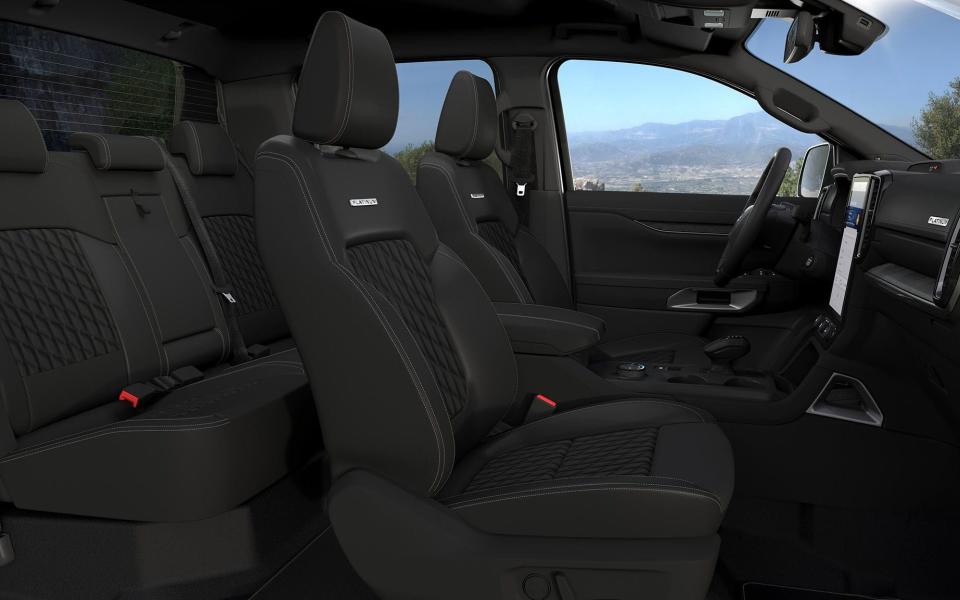
Spacious and practical
There’s more legroom, too, with Isofix child seat mounting points on the outer two seats. Meanwhile, in the front, the seats are comfy and the new dashboard is rather snazzy, with a vast touchscreen in the centre.
Happily, this doesn’t incorporate the climate controls, which are arranged in a row of physical buttons and dials beneath, making them instantly accessible all the time and very easy to use on the move.
The screen itself is good, too – a touch slow to respond at times, but its sheer size means all the on-screen buttons are large and easy to use, while the menus are well laid out.
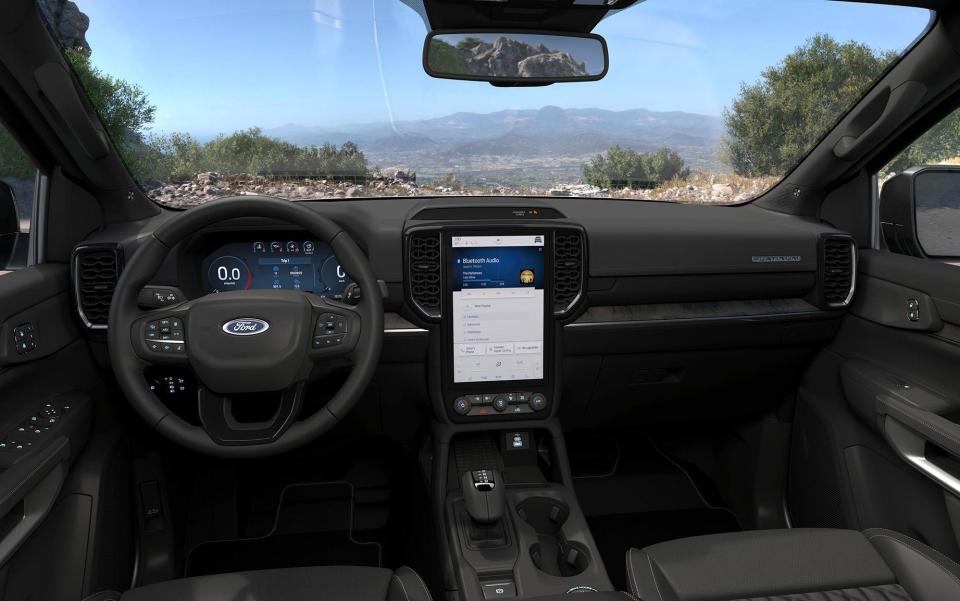
The rest of the dashboard is, by and large, finished in smart materials, lifted by the lines of ambient lighting that run through it. There are some scratchy materials low down, but by the standards of pick-up trucks these aren’t horrendous. Meanwhile, the big, plush seats are trimmed in quilted leather and feel suitably upmarket.
There are two obvious downsides with choosing a pick-up as a company car. The first is the lack of a boot – though this can be solved relatively easily by installing a load bed cover to turn the bed into one (and a sizeable one at that).
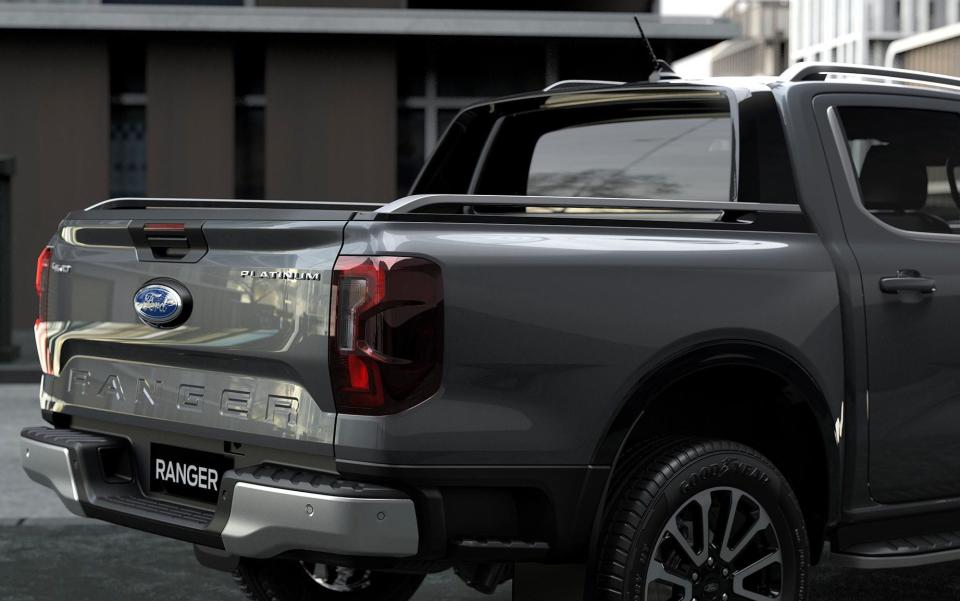
The second comes when you get on the road. Pick-ups have an old-fashioned body-on-frame construction, which makes them stronger and more rugged, but also results in a less controlled ride over bumps; that can make some downright uncomfortable.
Smooth and adroit
Fortunately, that isn’t the case here. In fact, the Ranger has always been one of the smoothest-riding pick-ups, hitherto only bettered by the Volkswagen Amarok – though now that the latest Amarok is based on the Ranger, that disparity is no longer.
And while it’s no sports car, the handling is pretty neat, too. The steering is rather vague, but the Ranger turns in tautly and, despite all that weight, it doesn’t lean over too much.
As you’d expect given the standard four-wheel drive, there’s a tonne of traction, and plenty of grip, too, so while there’s always that slight looseness you get from a body-on-frame vehicle, it’s minimised here, and the Ranger at least feels solid and secure. It’ll quite happily monster a green lane, too, as you’d expect.
Naturally, you’ll always have to deal with the Ranger’s sheer size around town. Its additional width – plus the height of the bonnet – don’t help with that. The controls are light and the pedals well calibrated, but even so squeezing through gaps is a challenge – as is using a multi-storey car park,
The new engine is suitably lusty, too, with a satisfying soundtrack and lots of low-down urge. It’s matched to a 10-speed automatic gearbox that might sound a bit excessive, but in the flesh it changes smoothly and swiftly, rarely feeling out of sorts.
The payoff for such a big, thumping engine in such a big, thumping vehicle is the fuel economy. Official figures put this at a wince-inducing 28mpg – expect that to mean around 25 on average in the real world. From a diesel. Given that this V6 Ranger chucks out 264 grams of CO2 for every kilometre it is driven (which works out at almost half a kilo per mile), this is definitely not a vehicle for those looking to save the planet.
The Telegraph verdict
Indeed, there’s a discussion to be had about whether incentivising people to choose thirsty, CO2-spewing pick-ups as their company cars is at all sensible.
But that’s a policy issue, one it seems unfair to make the Ranger in particular answer for. Having said that, it’s an issue to be aware of – because if you were to choose a plug-in hybrid company car instead, even if you didn’t charge it regularly, you’d likely be contributing somewhat less to the atmosphere’s stock of carbon.
But if you’re set on a pick-up, the Ranger is the one. You might consider one of the four-cylinder diesels – the twin-turbo is particularly good – to trim your fuel consumption and carbon output. But if you really need all that pulling power, or you’re willing to throw caution to the wind and spend your tax savings on fuel instead, the V6 is a fine way to do it.
After all, the Granada Scorpio had a V6 engine, too – and while it’s a very different kettle of fish in almost every way, this Ranger is just as fine a conveyance.
The facts
On test: Ford Ranger 3.0 V6 TDCi 240 Platinum Double Cab
Body style: four-door pick-up truck
On sale: now
How much? £45,900 plus VAT on the road (range from £28,275 plus VAT)
How fast? 112mph, 0-62mph in 8.7sec
How economical? 27.4mpg (WLTP Combined)
Engine & gearbox: 2,993cc six-cylinder diesel engine, 10-speed automatic gearbox, four-wheel drive
Maximum power/torque: 240bhp/443lb ft
CO2 emissions: 264g/km (WLTP Combined)
VED: £320
Warranty: 3 years / 60,000 miles
Spare wheel as standard: No
The rivals
Volkswagen Amarok 3.0 TDI 240 Style
240bhp, 28.0mpg, £46,362 on the road (plus VAT)
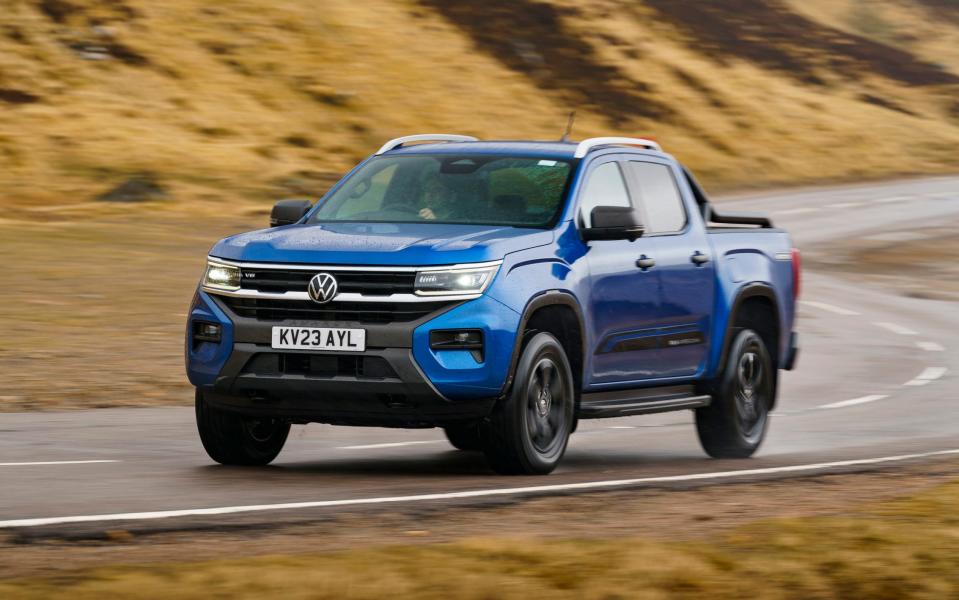
That the Amarok is now based on the same platform as the Ranger only serves to highlight how expensive the VW is. This version might have the same engine, yet it has much less equipment and costs slightly more. On the plus side, the Amarok has smarter interior trim, but no longer does it have the advantage on the road – the Ranger is a better deal.
Toyota Hilux 2.8 Diesel Auto Invincible X
201bhp, 30.0mpg, £38,688.33 on the road (plus VAT)
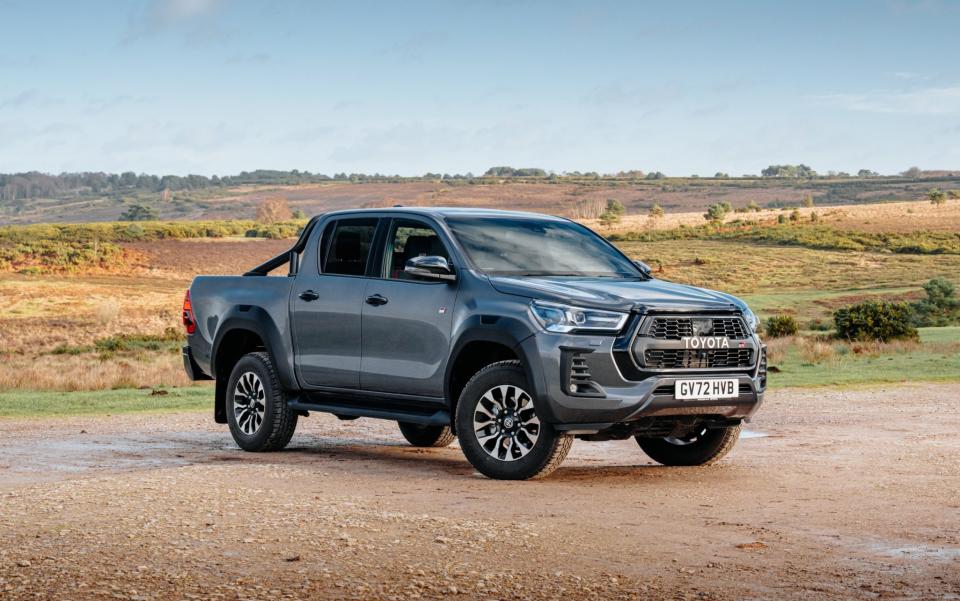
The workhorse of the group. Famed for its reliability, it should never let you down; even if it does, it can be had with a whopping warranty if you keep it serviced at a main dealer. The downside is that it’s less refined and less luxurious than the Ranger, with less power even in this top form and a cheaper-looking interior. But if you need to be certain your pick-up won’t let you down, this is the one.
Isuzu D-Max DL40
162bhp, 30.7mpg, £33,999 on the road (plus VAT)
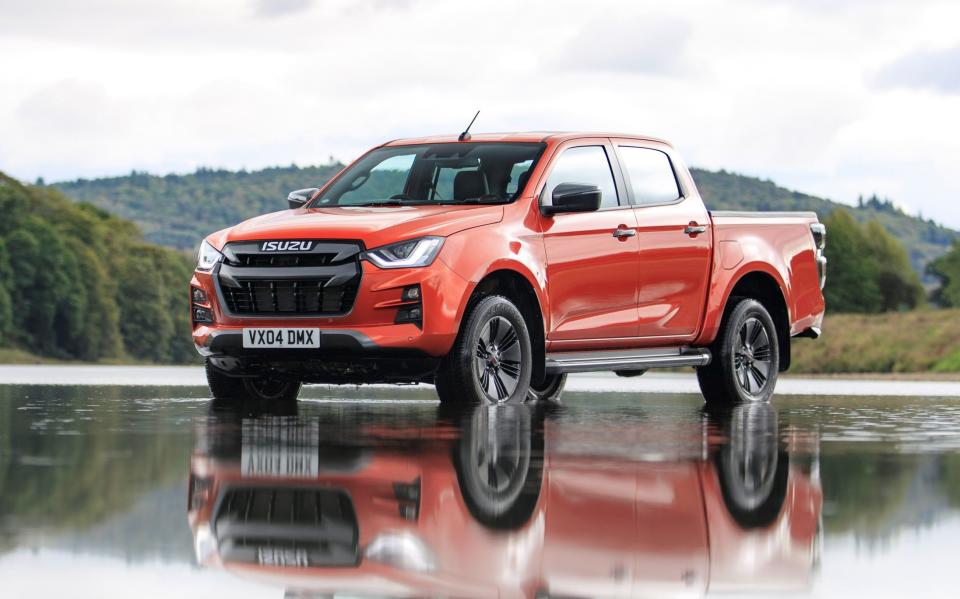
If money’s tight but you still want to live the pick-up life, the D-Max should pique your interest. But you get what you pay for, with a naff, plasticky interior, a noisy, weedy engine and an unsettled ride. And despite being almost 80bhp down on the Ranger, it’s not vastly more economical. On the plus side, the D-Max is accomplished off-road – so if you need to get to places other pick-ups wouldn’t (for less money), this is still worth a look.

